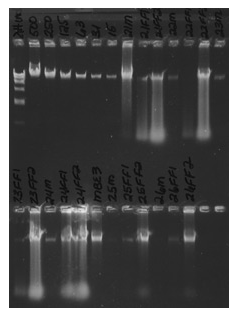Archival Notice
This is an archive page that is no longer being updated. It may contain outdated information and links may no longer function as originally intended.
Home | Glossary | Resources | Help | Contact Us | Course Map
The yield gel technique is a semi-quantitative/qualitative assay that allows for the estimation of the concentration and quality of DNA in a specimen. The method consists of the electrophoresis of DNA in an agarose gel matrix incorporating a fluorescent intercalating dye such as ethidium bromide (EtBr). The concentration of a sample can be determined by comparing the intensity of the fluorescence of the sample to that of the calibration standards.
One of the benefits of yield gels is the ability to assess the quality of the DNA sample. Larger (undegraded) DNA fragments migrate at a slower rate than those of lower molecular weight. Degraded DNA will consist of lower molecular weight fragments.
|
Safety Note: |
|
Ethidium bromide (EtBr) is a known carcinogen. |
Read more about capillary electrophoresis in course: Amplified DNA Product Separation.
(You may have to enter your Userid and password.)
Additional Online Courses
- What Every First Responding Officer Should Know About DNA Evidence
- Collecting DNA Evidence at Property Crime Scenes
- DNA – A Prosecutor’s Practice Notebook
- Crime Scene and DNA Basics
- Laboratory Safety Programs
- DNA Amplification
- Population Genetics and Statistics
- Non-STR DNA Markers: SNPs, Y-STRs, LCN and mtDNA
- Firearms Examiner Training
- Forensic DNA Education for Law Enforcement Decisionmakers
- What Every Investigator and Evidence Technician Should Know About DNA Evidence
- Principles of Forensic DNA for Officers of the Court
- Law 101: Legal Guide for the Forensic Expert
- Laboratory Orientation and Testing of Body Fluids and Tissues
- DNA Extraction and Quantitation
- STR Data Analysis and Interpretation
- Communication Skills, Report Writing, and Courtroom Testimony
- Español for Law Enforcement
- Amplified DNA Product Separation for Forensic Analysts


